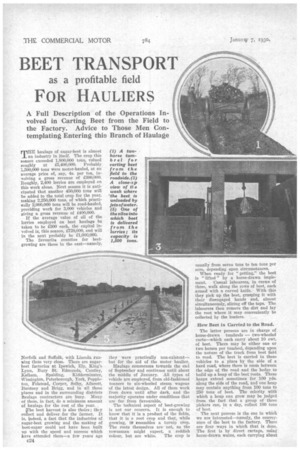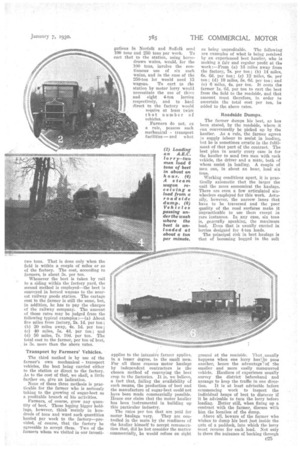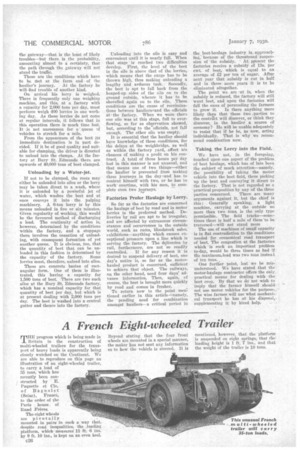BEET TRANSPORT
Page 46

Page 47

Page 48

If you've noticed an error in this article please click here to report it so we can fix it.
as a profitable field
FOR HAULIERS
A Full Description of the Operations Involved in Carting Beet from the Field to the Factory. Advice to Those Men Contemplating Entering this Branch of Haulage
THE haulage of sugar-beet is almost an industry in itself. The crop this season exceeded 1,800,000 tons, valued roughly at £5,400,000. Probably 1,500,000 tons were motor-hauled, at an average price of, say, 4s. per ton, involving a gross revenue of 1300,000. Roughly, 2,400 lorries are employed on this work alone. Next season it is anticipated that another 450,000 tons will be added to the total crop for the year, making 2,250,000 tons, of which praetirally 2,000,000 tons will be road-hauled, providing work for 3,000 vehicles and giving a gross revenue of £400,000.
If the average value of all of the brides employed on beet haulage be taken to be £300 each, the capital involved is, this season, £720,000, and will in the next probably be £1,000,000.
The favourite counties for beetgrowing are those in the east—namely.
Norfolk and Suffolk, with Lincoln runDing them very close. There are sugarbeet factories at Ipswich, Ely, King's Lynn, Bury St. Edmunds, Cantley, Kelham, Spalding, Kidderminster, Wissington, Peterborough, York, Poppleton, Felstead, Corper, Selby, Allseott, Bardney and Brigg, and in all these places and in the surrounding districts haulage contractors are busy. Many of them, in fact, do a minimum amount of haulage for the rest of the year.
Whe beet harvest is also theirs ; they collect and deliver for the farmer. It is, indeed, a fact that the industries of sugar-beet growing and the making of beet-sugar could not have been built up with the speed and success which have attended them—a few years ago they were practically non-existent-but for the aid of the motor haulier, Haulage commences towards the end of September and continues until about the middle of January. All types of vehicle are employed, from old-fashioned tonners to six-wheeled steam wagons of the latest design. All of them work from dawn until after dark, and the majority operates under conditions that are far from favourable, The technical aspect of beet-growing is not our concern. It is enough to know that it is a product of the fields, that it is a root crop and that, while growing, it* resembles a turnip crop. The roots themselves are not, as the townsman might expect, a reddish colour, but are white. The crop is usually from seven tons to ten tons per acre, depending upon circumstances. When ready for "getting," the beet is " lifted " by a horse-drawn imple ment. Casual labourers, in crews of three, walk along the rows of beet, each armed with a curved knife. With this they pick up the beet, grasping it with their disengaged hands and, almost simultaneously, slicing off the tops. The labourers then remove the dirt and lay the root where it may conveniently be collected by the loaders.
How Beet is Carried to the Road.
The latter persons are in charge of horse-drawn tumbrels — two-wheeled carts—which each carry about 10 cwt. of beet. There may be either one or two horses per tumbrel, depending upon the nature of the track from beet field to road. The beet is carried in these vehicles to a place by the side of a hard road, where there is room between the edge of the road and the hedge to build up a heap of the beet roots. These heaps extend sometimes for 100 yds. along the side of the road, and one heap may contain anything from 100 tons to 250 tons of beet. The celerity with which a heap can grow may be judged from the fact that a group of three pickers can, in a day, collect 100 tons of beet.
The next process is the one in which we are interested—namely, the conveyance of the beet to the factory. There are four ways in which that is done. The first is by direct cartage, using horse-drawn wains, each carrying about two tons. That is done only when the held is within a couple of miles or so of the factory. The cost, according to farmers, is about 3s. per ton.
Whenever the beet is taken by rail to a siding within the factory yard, the second method is employed—the beet is conveyed in horsed wagons to the nearest railway goods station. The cartage cost to the farmer is still the same, but, in addition, he has to pay the charges of the railway company. The amount of those rates may be judged from the following typical examples :—(a) About five niiles from factory, 2s. 1d. per ton; (b) 20 miles away, 4s. 1d. per ton; (c) 40 miles, 5s. 4d. per ton ; and (d) 50 miles, 7s. 10d. per ton. The total cost to the farmer, per ton of beet, is 3s. more than the above rates.
Transport by Farmers' Vehicles.
The third method is by use of the farmer's own mechanical transport vehicles, the beet being carried either to the station or direct to the factory. As to the cost of that, we shall, a little farther on, give an indication.
None of these three methods is practicable for the farmer who is seriously taking to the growing of sugar-beet as a profitable branch of his activities.
Farmers, of course, grow any quantity of beet. Those hiying bigger holdings, however, think mainly in hundreds of tons and want such quantities hauled per week to the factory—provided, of course, that the factory be agreeable to accept them. Two of the farmers whom we visited in our investi
gations in Norfolk and Suffolk send 100 tons and 250 tons per week. To cart that to the station, using horsedrawn wains, would, for the 100 tons, involve the conthymus use of six such WaillS, and in the case of the 250-ton lot would need 15 wagons. To cart to the station by motor lorry would necessitate the use of three and eight 4-ton lorries • respectively, and to haul direct to the factory would require at least twice that number of vehicles.
Farmers do not, as a rule, possess such mechanical transport facilities— and what applies to the intensive fanner applies, in a lesser degree, to the small men: For all these reasons motor haulage by independent contractors is the chosen method of conveying the beet crop to the factories. It is, we believe, a fact that, failing the availability of such means, the production of beet and the manufacture of sugar-beet could not have been made commercially possible. Hence our claim that the motor haulier has been instrumental in building up this particular industry.
The rates per ton that are paid for
motor haulage vary. They are controlled in the main by the readiness of the haulier himself to accept remuneration that, did he but consider the matter commercially, he would refuse on sight
as being unprofitable. The following
nre examples of what is being received by an experienced beet haulier, who is making a fair and regular profit at tho work :—From (a) 16 miles away front the factory, 7s. per ton; (b) 14 miles, 6s. 6d. per ton; (c) 12 miles, 6s. per ton ; (d) 10 miles, 5s. 6d. per ton; and (e) 6 miles, 4s. per ton. It costs the farmeris. 6d. per ton to cart the beet from the held to the roadside, and that amount must therefore, in order to ascertain the total cost per ton, be added to the above rates.
Roadside Dumps.
The farmer dumps his beet, as has been stated, by the roadside, where it can conveniently be picked up by the haulier. As a rule, the farmer agrees to supply labour to assist in loading, but he is sometimes erratic in the fulfilment of that part of the contract. The best plan in nearly every ease is for the haulier to send two men with each vehicle, the driver and a mate, both of whom assist in loading. A couple of men can, in about an hour, loadsix tons.
Working conditions apart, it is practically axiomatic that the larger the unit the more economical the haulage. There are even a few articulated sixwheelers employed for this work. Actually, however, the narrow lanes that have to be traversed and the poor quality of the road surfaces make it impracticable to use them except in rare instances. In any case, six tons is, generally speaking, the maximum load. Even that is usually carried in lorries designed for 4-ton loads.
The principal risk in beet haulage is that of becoming bogged in the soft
ground at the roadside. Thatialsually happens when one lorry has':to pass another, hence the advantage:of the smaller and more easily manteuvred vehicle. Hauliers of experience usually survey the district beforehand and arrange to keep the traffic in one direc
tion. It is at least advisable before commencing work to inspect the individual heaps of beet to discover if it be advisable to turn the lorry before loading. Better still, when fixing up a contract with the farmer, discuss with him the location of the dump.
Above all, beware of the farmer who wishes to dump his beet just inside the gate of a paddock, into which the lorry must reverse for each load. Not only is,there the nuisance of backing through the gateway—that is the least of likely troubles—but there is the probability, amounting almost to a certainty, that the path through the gateway will not stand the traffic.
Those are the conditions which have to be Met at the farm end of the haulier's journey. At the factory he will find trouble of another kind.
On arrival his lorry is weighed. There is frequently only oue weighing machine, and this, at a factory with a capacity. for 2,000 tons per day, must perforce weigh 400 lorries in one working day. As these lorries do not come at regular intervals, it follows that in this operation there is much time lost. It is not uncommon for a queue of vehicles to stretch for a mile.
From the appearance of the beet its immediate destination is in part decided. If it be of good quality and suitable for clamping, the driver is directed to unload into the clamps. At the factory at Bury St. Edmunds there are upwards of 40,000 tons of beet clamped.
Unloading by a Water-jet.
If not to be clamped, the roots may either be unloaded into silos or the lorry may be taken direct to a wash, where it is unloaded by a powerful jet of water, which washes the beet and at once conveys it into the pulping machinery. A 6-ton lorry is by this means unloaded in five or six minutes. Given regularity of working, this would be the favoured method of discharging a load. The continuity of action is, however, determined by the conditions within the factory, and a stoppage there involves the cessation of unloading, with consequent formation of yet another queue. It is obvious, too, that the quantity of beet that can be unloaded in this fashion is determined by the capacity of the factory. Some lorries must, therefore, unload into silos.
These are concrete basins of rectangular form. One of them is illustrated, this having a capacity for 1.500 tons of beet. There are two such silos at the Bury St. Edmunds factory, which has a nominal capacity for that quantity of beet per day, but which is at present dealing with 2,000 tons per day. The beet is washed into a central gutter and thence into the factory.
Unloading into the silo is easy and convenient until it is nearly frill. When that stage is reached two difficulties develop. First, the level of the beet in the silo is above that of the lorries, which means that the cargo has to be thrown high, thus making unloading a lengthy and arduous task. Secondly, the beet is apt to fall back from the heaped-up sides of the silo on to the ground outside, whence it has to be shovelled again on to the silo. These conditions are the cause of recriminations between haulierseand the -officials at the factory. When we were there one silo was at this stage, full to overflowing, so far as observation showed, but, according to theofficials, not full enough. The other silo was empty.
It is essential that the haulier should have knowledge of these conditions, for the delays at the weighbridge, as well as within the factory yard, affect his chances of making a profit on his contract. A total of three hours per day lost in this manner is not unusual, and that means one of two things—either the haulier isprevented from making three journeys in the day !and has to content himself with two, or he has to work overtime, with his men, to complete even two journeys.
Factories Prefer Haulage by Lorry.
So far as the. factories are concerned the haulage of beet by road and in motor lorries is the preferred method. Deliveries by rail are apt to be irregular, and are affected by extraneous circumstances and occurrences in the outside world, such as races, bloodstock sales, exhibitions—anything which causes exceptional pressure upon a line which is serving the factory. The deliveries by rail, furthermore, are not so readily controlled. If for any reason it is desired to suspend delivery of beet, one day's notice is, so far as the motorhauled product is concerned, sufficient to achieve that object. The railways, on the other hand, need four days' advance information. Then, again, of course, the beet is brought more quickly by road and comes in fresher.
To return now to the point mentioned earlier in this article—namely, the pending need for combination amongst hauliers--n critical period in
the beet-haulage industry is, approaching, because of the threatened suspen sion of the subsidy. At nreseut the factories receive a subsidy of 13s. per cwt. of beet, which is equal to an average of £2 per ton of sugar. After next year that subsidy is cut in half and in three more years it is to be eliminated altogether.
The point we are at is, when the subsidy is reduced, the factory will still want beet,and upon the factories will fall the onus of persuading the farmers
to grow if. Is there anything more likely than that these two :parties to the contrirct will discover, or think they discover, in the haulier a source of economy? He will be unable adequately to resist that if he be, as now, acting individually. That is why we recommend combination now.
Taking the Lorry into the Field.
We have not, in the foregoing, touched upon one aspect of the problem of beet haulage, which has of late been the subject of much attention—namely. the possibility of taking the motor vehicle into the beet field, there picking up the beat and conveying it direct to the factory. That is not regarded as a practical proposition by any of the three
parties concerned. There are many arguments against it, but the chief is this : Generally speaking, a light machine, carrying at the outside no more than two tons, is the only type permissible. The field tracks—sometimes there is half a mile of them-to be traversed—will not stand more
The use of machines of small capacity is in fiat contradiction to the conditions needed for economical road transport of beet. The congestion at the factories which is such an important problem to-day, would be three times as bad if the maximum/load was two tons instead of ten tons.
One further point, lest we be mis-. understood. We have stated that the motor-haulage contractor offers the only practical means for dealing with the beet crop. By that we do not wish to imply that the farmer himself should, : not use motor vehicles for the purpose.. The wise farmer will use what mechanical transport he has at his diSposal
supplementing it by hired help. .












































































































